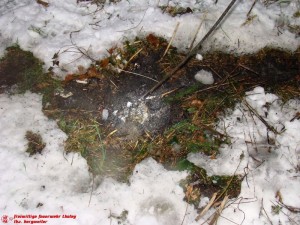Incidents Involving Electricity
Electricity is not only eerie, but can also cause quite a spectacle. The Bergweiler Fire Department was involved in two incidents that dealt with a torn power line. Both incidents occurred in a winter landscape setting, which can certainly evoke romantic feelings. Still, one should be aware of the dangers that go along with firefighting incidents.
I have a great deal of respect for things I can’t see. That’s why I’m not a huge fan of hazardous material, electricity or gas incidents. Those are all situations where I probably won’t know what the deal is until it’s maybe already too late. So, things are a little bit easier with, say, an out-in-the-open roof structure fire, where the element of surprise is not quite as high.
But before we take a look at the boring distance charts we dealt with during basic training, here is a great video the Bergweiler buddies made. During this incident and this one, a power line has torn, and the firefighters were called into action. Luckily, the whole thing happened during the wintertime, so the damage and fire hazard were containable. But it motivated me to think about distances when it comes to torn power lines and what distance I have to keep when using nozzles.
[MEDIA not found]
A big thanks to Sascha for making the pictures and the video available. By the way, the fire effect in the video is due to the flowing electricity. At the end of the video, when everything is turned off, the flames immediately go down, too. The power line probably had about 20,000 volt running through it.
As nights are getting longer again and temperatures are getting colder, all fire departments will most likely have to deal with torn power lines at some point. So let’s take a look at the possible dangers to make sure we know what to look out for:
- Breathing poisons: no, as long as nothing is on fire; and any danger out in the open is rather minimal
- Fear response: no
- Spread: yes, due to flammable materials surrounding the power line
- Atomic dangers: no
- Chemical dangers: no
- Sickness: no
- Explosion: no
- Electricity: yes
- Structural collapse: yes, there might be a tree stuck in the power line or the line might come down even further
So, it’s still relatively manageable, and as long as a certain distance is kept, the area is blocked off, and fire safety is ensured, you should be able to keep most of it under control. Everything else is the job of the responsible energy provider anyway.

Lucky, lucky: Aside from a little greenery, nothing caught on fire. (Picture: Bergweiler Fire Department)
When blocking off an area, the question is how big the radius around the loose-hanging power line should be. Current firefighter literature recommends a person keep a minimum distance of 20 meters in the event of high voltage (over 1,000 volt). Why? A loose-hanging power line creates a so-called potential gradient, which means that the earth below is charged with electricity. The charge level decreases when a person’s distance to the power line is increased. If you now march towards the loose-hanging power line with huge steps, you will have various different charges right at your feet (the foot that’s closer to the power line and the one that’s further away). Due to these varying charges, electricity runs through your body, even if you’re not touching the loose-hanging power line. Also, a person has to be aware of whether or not the torn power line is touching anything else. For example, if it’s touching a metal railing, said railing is also charged with electricity. In that case, the entire railing needs to be blocked off, too.
In the event of a secondary fire, it’s important to know the distances that must be kept with the nozzle. The following chart should be familiar to all firefighters:
| Low voltage (up to 1,000 volt) | High voltage (more than 1,000 volt) | |
| Spray jet | 1 meter | 5 meters |
| Full water jet | 5 meters | 10 meters |
Because our incident example deals with a power line that has more than 1,000 volt, we have to maintain a safety distance with our nozzle of about five or ten meters. For all of you who aren’t good with numbers, you should at least try to remember 10 meters, just to be on the safe side. By the way, energy providers themselves use additional terms for classifying charges: What we consider to be high voltage barely makes them flinch. But, as previously mentioned, in the firefighting world we only have the 1,000 volt limit to divide voltages into high and low.
I hope this article helped you retrieve some information that was stored in the back of your brain. If you want to read more about this topic, you can do so here. I look forward to reading your comments about incidents you had that involved electricity. If you have other interesting things about your fire department that you want me to write about on feuerwehrleben.de, just send me an e-mail, like Sascha did.
Tags: electricity, high voltage, incident


